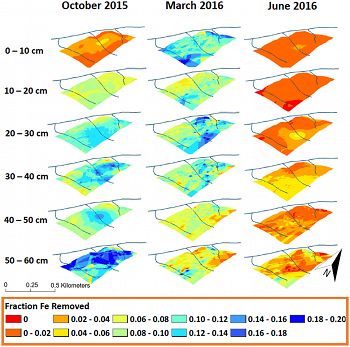Hodges et al., 2019
Seasonal and spatial variation in the potential for iron reduction in soils of the Southeastern Piedmont of the US
Hodges, Caitlin, John Mallard, Daniel Markewitz, Diego Barcellos, AaronThompson (2019)
CATENA 180: 32-40
-
Calhoun, Shale Hills, GRAD STUDENT
-
Calhoun, GRAD STUDENT
-
Calhoun, INVESTIGATOR
-
Calhoun, Luquillo, GRAD STUDENT
-
Calhoun, Luquillo, INVESTIGATOR, COLLABORATOR
Abstract
Ordinary Krig of fraction of Fe removed at 10-cm depth intervals from steel IRIS rods during October 2015, March 2016, and June 2016 at the Calhoun CZO, SC. Warm colors represent lower potential for Fe reduction, and cool colors represent higher potential for Fe reduction.
Soil iron reduction influences ecosystem function by altering the cycling of carbon, nutrients, and trace elements in both the aqueous and solid phases. Most of our understanding of soil iron reduction comes from work on saturated soils. However, recent research indicates that iron reduction can be a pivotal process in upland soils that experience dynamic redox conditions. We hypothesized that in upland soils, iron reduction intensity and prevalence could be predicted by temporal and spatial variations in soil conditions. We tested this by delineating the spatial and temporal distribution of the potential for iron reduction using Steel IRIS probes to 70 cm depth in well-drained, highly weathered soils of the Southeastern US Piedmont. Measurements were taken under three soil moisture conditions over the course of a year bracketing the seasonal wet period: (a) after an extreme rainfall event in October 2015; (b) during the end-of-winter warming in March 2016; (c) and during a period of high evapotranspirational demand in June 2016. Results indicate that the potential for iron reduction varied with depth and moisture conditions over the year. Iron reduction was greatest in the subsurface (20–60+ cm) following a rainfall event that generated prolonged subsurface soil saturation [fraction of FeIII removed from the rods (XFe-removed of 0.14 ± 0.003 at 50–60+ cm in October 2015)]; whereas the potential for iron reduction was distributed throughout the soil profile in late winter/early spring (average XFe-removed across depths of 0.104 ± 0.007) when biological oxygen demand was likely high due to high soil moisture, labile carbon availability, and soil warming. In June 2016, the potential for Fe reduction was low (XFe-removed < 0.04) except at the 50–60+ cm depth increment (XFe-removed 0.07 ± 0.01). Across these three sampling periods, landscape attributes and soil conductance measured by electromagnetic induction explained up to 30% of the spatial variance in XFe-removed. Our results demonstrate that these well-drained Ultisols likely experience strong seasonal trends in Fe reduction rates, as well as periodic spikes in Fe reduction from high soil moisture events. These temporal patterns suggest Fe respiration influences not only wetland, but also upland soil biogeochemistry.
Citation
Hodges, Caitlin, John Mallard, Daniel Markewitz, Diego Barcellos, AaronThompson (2019): Seasonal and spatial variation in the potential for iron reduction in soils of the Southeastern Piedmont of the US. CATENA 180: 32-40. DOI: 10.1016/j.catena.2019.03.026
 This Paper/Book acknowledges NSF CZO grant support.
This Paper/Book acknowledges NSF CZO grant support.
Explore Further






